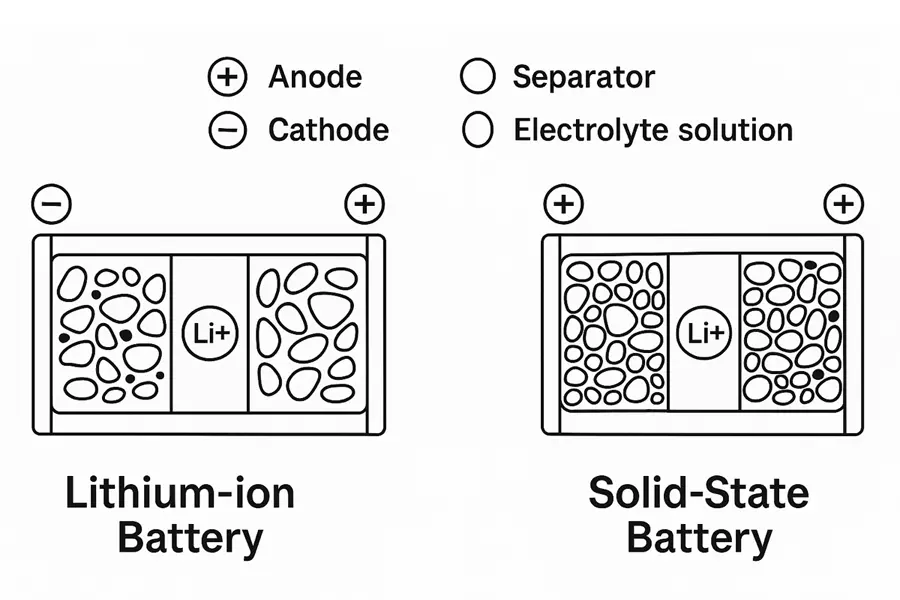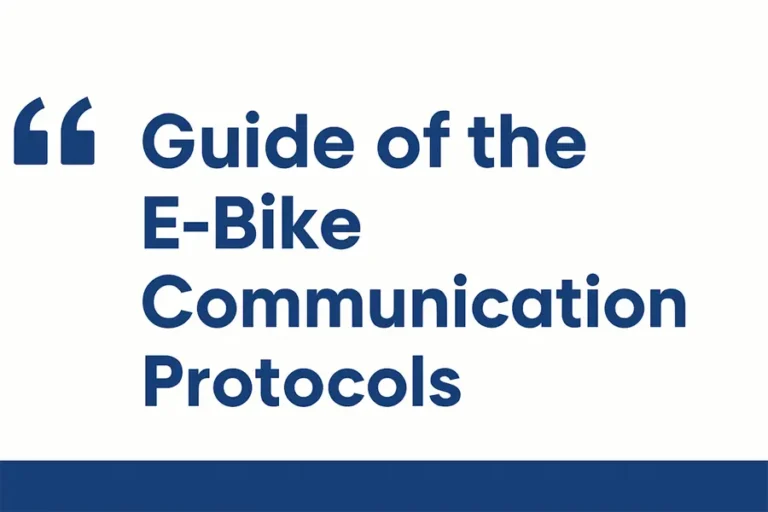Solid state batteries (SSBs) are poised to revolutionize the e‑bike industry by replacing flammable liquid electrolytes with solid conductive materials—often ceramics or polymers—that promise double the energy density, rapid charging in minutes, enhanced safety, and longer lifespans compared to today’s lithium‑ion packs . Industry pioneers like Stromer and Urtopia are already unveiling ride‑ready prototypes using ceramic SSB technology, amid broader solid‑state breakthroughs in automotive and consumer electronics . With regulatory pressures mounting—especially around battery safety—and scale‑up efforts accelerating globally, the stage is set for solid‑state to transition from lab to e‑bike over the coming years, potentially becoming the premium standard by late decade.
1. Solid‑State Batteries: What Makes Them Game‑Changing
Core innovation: SSBs replace the liquid or gel electrolyte found in conventional lithium-ion (Li‑ion) batteries with a solid medium—ceramic, polymer, or sulfide—that shuttles lithium ions between electrodes . This seemingly small shift can unlock multiple performance advantages:
- Energy density: While Li‑ion e‑bike batteries average 150–250 Wh/kg, SSBs claim 300–800+ Wh/kg in early projections—potentially doubling range or halving weight .
- Safety: Solid electrolytes don’t leak and are not flammable, virtually eliminating thermal runaway risk .
- Charging speed and longevity: Prototypes suggest charging in minutes and surviving 10,000+ cycles (10–15 years) before losing 10% capacity—far superior to Li‑ion’s 2–3k cycle lifespan .
- Materials and sustainability: Some SSB designs reduce or eliminate cobalt and rely on abundant materials, easing ethical sourcing concerns .
For e‑bike riders, these translate into longer trips, lighter batteries, safer operation, rapid charging, and less frequent replacements.
2. What Are Manufacturers Doing Right Now?
Pilot projects & prototypes
- Stromer (Swiss e‑bike maker) has built a ceramic‑electrolyte SSB prototype, claiming “practically doubling potential of Li‑ion batteries” and expecting commercialization in a few years .
- Urtopia’s Titanium Zero e‑bike also leverages early‑stage SSB tech .
- TD Hitech Energy (Taiwan) and ProLogium are leading SSB R&D; both aim to bring products to market late‑decade .
Automotive & scale‑up developments
Many large battery labs and automakers (Toyota, Volkswagen, Hyundai, Stellantis–Factorial, Honda, etc.) are advancing SSBs for cars—testing scale, materials, and manufacturing methods .
Although these vehicles are far larger scale, breakthroughs in automotive SSB manufacturing have downstream benefits for e‑bikes—specifically economies of scale and proven materials.
3. Major Roadblocks Remain
A. Scale & cost
- Tiny cells vs. packs: SSBs currently exist mostly as coin‑cells for wearables; scaling to e‑bike sizes demands new factories and processes .
- Expense: Production costs are roughly 8× Li‑ion per kilowatt-hour and require cleanrooms, vacuum deposition equipment, and precise assembly .
B. Mechanics & long‑term stability
- Brittleness & dendrites: Ceramic electrolytes are brittle; lithium‑metal anodes form dendrites that can penetrate and cause shorting. Research into toughened ceramics (e.g., ferroelastic designs) is ongoing, but challenges remain .
- Interface degradation: Maintaining stable contact across cathode/electrolyte interfaces is tricky; small mechanical or chemical instability can cause degradation over cycles ().
C. Energy‑density and temperature range
- Some SSBs struggle at low temperatures and need constant pressure to maintain connectivity—adding engineering complexity ().
4. Why the e‑Bike Shift Might Happen Faster Than You Think
Safety as differentiator
Many riders store e‑bike batteries in homes or apartments. The inherent fire‑risk of Li‑ion is a liability; solid‑state alternatives promise major peace of mind.
Use‑case suitability
- Lightweight, modular packs: An e‑bike battery is orders of magnitude smaller than a car’s. While that simplifies issues like pressure management, it also requires smaller manufacturing runs—but with enough precision, small‑scale facilities (or conversion of Li‑ion lines) may suffice.
- Price premium tolerance: A 15 Ah SSB pack built for high‑end e‑bikes might fetch $400–600, with early adopters willing to pay for 2× range, rapid charging, and longer life.
Policy and regulation
China plans to enforce new battery safety regulations by 2026, potentially pushing e‑bike makers there to adopt safer chemistries . That could ripple globally as standards shift.
5. Timeline Outlook
| Phase | 2025 | 2026–2028 | 2029–2032 |
|---|---|---|---|
| Research+Prototypes | Stromer, TD Hitech pilots; automotive R&D speed-ups | Early pilot e‑bike units; small-batch manufacturing; auto-SBB factory scale‑up | First gen of mass‑market SSB e‑bikes; incremental price drops |
| Cost curve | ~8× Li‑ion cost | ~4–6× Li‑ion cost (on higher-end SKUs) | ~2–3× Li‑ion cost; still premium |
| Performance & safety | Proof-of-concept; lab safety tests; rideable prototypes | Charging in 15–20 min; tested >3k cycles; solid-cell reliability vetted | Range 2× Li‑ion, fast-charging, >5k cycles, wider temperature operation |
6. Opinions from Experts
A consultant familiar with Samsung SDI’s SSB work predicted in 2022: “we won’t see solid‑state Li‑ion e‑bike battery packs in widespread use for the next three to five years” . That still aligns with a 2027–2029 broader rollout.
From Reddit in the EV sector:
“If the scientists figure out a solution that works, the industry will pivot. But under current tech, EVs work.”
This captures the broader consensus: Li‑ion is “good enough” now—but if SSBs clear the final hurdles, adoption could accelerate rapidly.
7. External Innovation Catalysts
- Automotive SSB investment: Companies like Factorial–Stellantis (FEST® cells), Honda, Toyota, QuantumScape, ProLogium, and WeLion are actively innovating at scale .
- U.S. backing: Several startups (e.g., Ion Storage Systems) have begun deployment in consumer electronics—50% longer lifetime, faster charging, ceramically stiff, compatible with standard factories . This progress is cross-industry, benefiting e‑bike potential.
- China regulation: New safety standards in China (enforcement starting 2026) may force upgrades in battery chemistries .
8. Conclusion: Likelihood of a Pivot
Yes—a pivot toward solid‑state e‑bike batteries is likely, but on a gradual, multi‑stage timeline:
- By 2027–2028, expect early boutique/high‑end models with SSB packs, especially in regions with safety regulation pressure.
- By 2029–2032, progress in manufacturing and costs could move SSBs into mainstream e‑bikes—especially where users value lightweight, high‑range, or fast‑charging batteries.
- However, Li‑ion will remain dominant for most affordable models through the 2020s, thanks to mature supply chains and lower cost.
So, while it’s not a sweeping overnight pivot, SSBs are on track to redefine premium e‑bike power systems by late‑decade, supported by breakthroughs from the auto, electronics, and materials‑science sectors.
9. What to Watch
- Automotive SSB scale‑up announcements (Toyota, Honda, Factorial, etc.); automotive success unlocks tooling for e‑bikes.
- Pricing trends—when solid‑state packs reach <$2,000/kWh it’ll become viable for high-end e‑bikes.
- Regulatory developments—e‑bike safety mandates in China, EU, US could accelerate safety-driven adoption.
- Pilot e‑bike units—watch small‑run models debuting in 2026–2028; their reception will be key.
Final Word
Yes, a shift toward solid‑state e‑bike batteries is technically feasible and increasingly likely—but it hinges on overcoming cost and manufacturing bottlenecks. We’re probably 3–7 years away from seeing SSBs in everyday mid‑tier bikes, even if luxury or specialist models appear earlier. The pivot won’t revolutionize the market overnight—but once SSBs reach economies of scale, safety and performance advantages may rapidly make them the new premium standard.
Let me know if you want deeper profiles on key companies, materials science, or regional policy drivers—and thanks for riding along!






